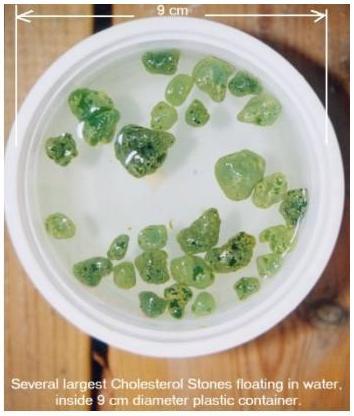A. Gallstones from three human beings
(large one on right - "2.3 cm from end to end"); undefined as to
type and now "disappeared," I suspect all would have been classified as
pigment stones, but the broken ones exhibit characteristics that
suggest they were composite (i.e.,
"mixed") stones. (© photo
by Augustine G. DiGiovanna, Salisbury University; from http://www.biologyofhumanaging.com/,
used with
permission)

B. Gallstones. Cholesteral
gallstones -- note size and caption on photograph. (photo in public domain (per Vijnana
Executives Sonja & Krishnaprem); from www,auroville.com
www,auroville)

C. Gallstones. Sizes
are variable. a. tetrathedron - rough sketch of several I saw in
the 1930s; b. subcrystalline
shape with rounded edges and corners; c. portion of globular
stone that exhibits
concretionary growth. (b
& c images retouched, etc.-- from advertisements for gallstones of
oxen on www.geocities.com
& www.ec21.com)